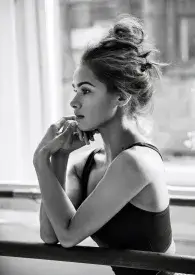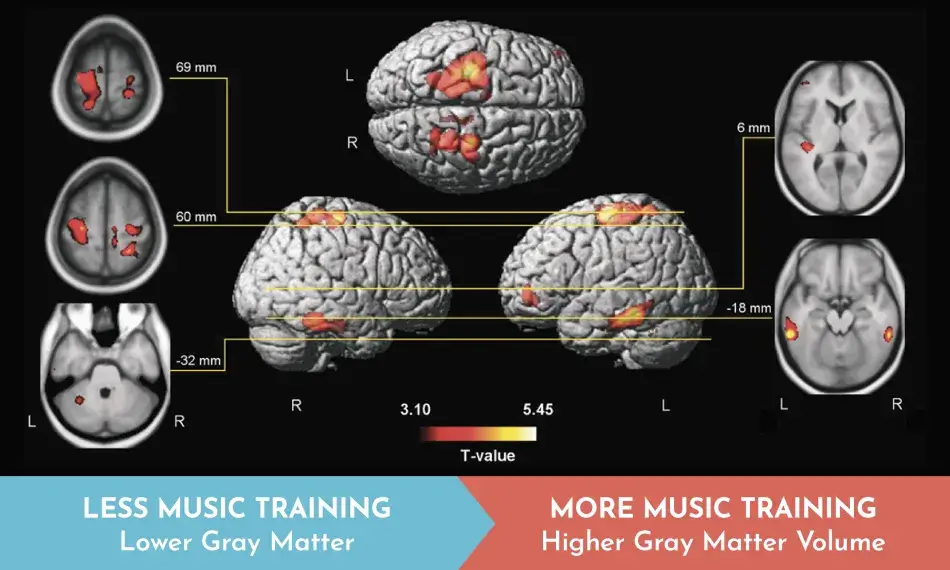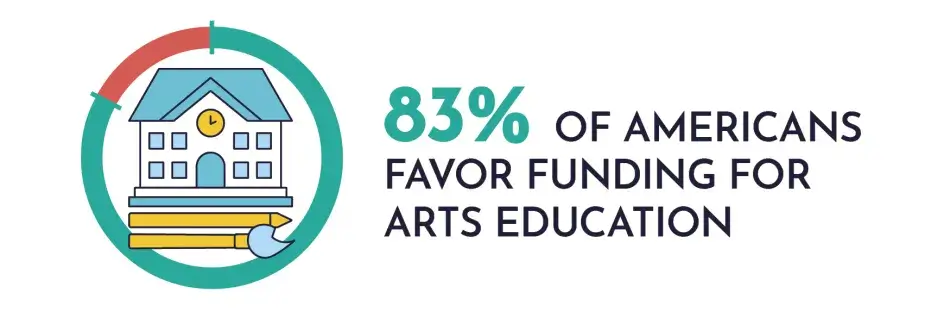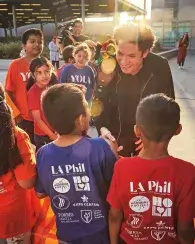The Arts and Public Education
“As democracy depends on civil society . . . so civil society depends on the arts . . . democracy ultimately rests on the arts’ commitment to free creativity, liberal diversity, and unfettered imagination. A government that supports the arts and humanities is not engaging in philanthropic activity but assuring the conditions of its own flourishing.”
—Benjamin Barber
Introduction
By any measure, the arts should stand at the heart of a strong public education. An education without the arts—a fundamental mode of human expression—is incomplete. But the value of arts education is deeper. The arts are a rich source of history and cultural identity. Learning from the voices of different cultures and histories provides the opportunity to reflect on the complexity of human experience across time and place.
The arts give us opportunities to contemplate meaning and engage in personal reflection and provide comfort in times of crisis. The arts can challenge our perspectives, giving us new ways to see and experience the world, cultivating the values of diversity, tolerance, and empathy.1 The arts impart valuable cognitive, critical thinking, and technical skills used by artists and non-artists in their livelihoods, strengthening our economy.2 The arts strengthen social ties in our schools and communities and enhance civic engagement, strengthening civil society.3 Finally, the arts enhance educational engagement and a desire to learn more. Childhood exposure to the arts inculcates a lifelong desire to engage in the arts. In sum, arts education is central to the core mission of public education—to equip a citizenry for self-government—and recognition of this fact is long overdue.
Sadly, the education system often fails to hold arts education in high esteem. Faced with budget constraints and rising accountability pressures, policy-makers and administrators have to make difficult decisions about the availability of the arts in schools. As a result, access to arts education has declined. In some cases, it is treated as a complement to other subjects, an elective, or a frill. In other cases, it has been eliminated entirely.4 And the reliance on property taxes to fund school districts creates an uneven distribution of funding between wealthy and underresourced neighborhoods that exacerbates racial disparities in student access to an arts education.
These reductions and inequities fit against a backdrop of other troubling trends with serious implications for our democracy and national well-being. Nationally, we are more divided than ever. We have recently witnessed the legitimacy of our system of government weakened, the value of our free press undermined, and intolerant views emboldened. Crimes motivated by racial and religious bigotry are occurring at heightened levels, and the number of hate groups in the United States has been steadily increasing.5 Against this backdrop, our youth are suffering. Mass school shootings have become commonplace. Adolescent depression and anxiety have been steadily rising, and suicide rates among young people are at a twenty-year high.6
In the midst of these education crises, the world has been challenged by the COVID-19 global pandemic, which has drastically changed the lives of students and families across the world, exposing them to illness, job loss, housing displacement, and the devastating loss of friends and family. The strain on school budgets due to the economic challenges of the pandemic response has also negatively impacted arts education, including cuts to arts programs.7 These impacts have disproportionately affected Black, Indigenous, and Latinx communities, and proximity to this tragedy has dire effects on the mental health of children and youth.8

“As a dancer and as an artist, I’m forever a student, and I have so many incredible teachers that have influenced me and gotten me to where I am today. Growing up the way that I did—in underprivileged communities, one of six children in a single-parent home, changing schools constantly—I was twelve-and-a-half years old the first time I had a teacher that made me feel seen and heard and not judged. . . . It was the first time that I really decided I was going to go for something outside of my comfort zone, and it was the first time I was venturing into performing and dancing. It was the only thing that allowed me to feel like I was really expressing myself in a way I was comfortable. . . . Dance allowed me to develop as a person and as a human being. . . . [Without my dance teacher] I wouldn’t be—not just what people see: the first Black principal ballerina at American Ballet Theater—but I wouldn’t be the woman that I am today, and I think that’s what’s so incredible and important about arts in public schools in particular and dance as an art form in public schools. . . . I am forever grateful for that opportunity.”
—Misty Copeland, Principal Ballerina at American Ballet Theater
One would be hard pressed to look at America in 2021 and not acknowledge the crisis in the health of our democracy, our social lives, our collective mental health, and our ability to interact peacefully and civilly. John Dewey argued that schools were the key to creating citizens who could maintain a democracy.9 If the fundamental measure of a quality education is the health of our democracy, recent events suggest we are falling short of the ideal.
Although not nearly enough data are available in this area, evidence shows that arts education can play a vital part in the solution. We have all witnessed the powerful roles the arts play in people’s lives—as a means to cope with loss, discover a sense of meaning and belonging, and as a way to experience joy. We have also seen how the arts move us to empathize with others, challenge us with different points of view, and play a unifying role in social movements. Take the devastating effects of the pandemic on the well-being of children as an example: As we look toward the long process of recovery, we can be confident that arts education will facilitate emotional well-being, reconnects students with friends and teachers, and foster resiliency.10
For all Americans to reap the full benefits of the arts, we need to ensure that access to arts education is not merely a privilege enjoyed by some but a right guaranteed to all. This report builds on past research linking the arts and arts learning to social and emotional development, while also trying to push past old and obsolete notions. One example is the use of the term tolerance. Terminology that is more culturally responsive and centered on equity, such as acceptance, will be more useful for an increasingly diverse nation where only understanding and acceptance can bring people together effectively. If arts education is to serve all students, it needs to be situated within our present need for social justice.

“When I was fourteen years old, I was going through a rough patch. I was abusing drugs and alcohol, and it wasn’t looking good. Luckily, I met a teacher that would change my life. . . . She was a theater teacher at my school. . . . Through her joy and her passion for theater, she was able to find deep reservoirs of creativity inside me and inspired me to get the hell out of my rut that I was in—my death spiral—and just have fun. And it doesn’t sound important when I say it, you say, ‘Fun? You could just go out and play stickball in the street, go ride a bike.’ It’s not the same kind of fun: theater fun is like a communicative fun, it’s a healing kind of fun, it’s a joy. And by the way, I learned more in that theater class than I did in any of my other studies—English, mathematics. . . . My brain grew twelve sizes thanks to theater, and not only that, it built confidence and muscles in my soul. I can clearly chart a path on my life’s journey through the theatrical productions I was a part of and my theater teachers—God bless them all. I’m a firm believer that every school in this country should have a theater arts program. It saved my life, and I love it.”
—Jack Black, Actor and Musician
To make the case for the importance of arts education, we first review some of the research on the benefits of arts education while highlighting current inequities in access. Then (in The Values of Arts Education) we offer a more expansive frame for articulating the benefits of arts education, drawing on personal examples from a few of the many people who shared their stories with us. Finally (in Policy Recommendations), we lay out a comprehensive set of tangible policy recommendations that can bring us closer to our goal of ensuring every student in the United States has access to a quality arts education.
Prior Research on the Benefits of Arts Education
Educational theorists and practitioners have articulated a variety of potential benefits for the arts. Most broadly, some note that the arts are a way of imparting the rich history of the human experience. As some scholars have put it, “the arts are a fundamentally important part of culture, and an education without them is an impoverished education leading to an impoverished society.”11 Some note that arts education is particularly beneficial because it helps develop self-expression and creativity or because it enhances cognitive and critical thinking skills.12 Others argue that the arts learning process builds qualities in students that are essential for a democracy.13
Emerging empirical research testing such theories sheds new light on some of the measurable benefits of the arts. Early correlational studies identified relationships between the arts and other academic outcomes, such as improved test scores and higher graduation rates.14 Some scholars and stakeholders have resisted framing the benefits of the arts this way, however, and have questioned the validity of research that does not demonstrate causal relationships.15 More recent studies have approached the topic with increased rigor and a broader focus on the types of benefits gained from arts education. One pioneering study of a school-museum partnership program demonstrated a causal link between arts education and critical thinking outcomes,16 increased tolerance, increased empathy,17 and higher motivation to engage with arts and culture.18 More recent rigorous studies have found improvements in students’ standardized writing scores, reductions in disciplinary infractions, increases in students’ compassion for others, increased school engagement, improved attendance, and higher college aspirations.19 Growing research about music’s impact on brain development offers another insight into the importance of a robust arts curriculum for every student. Researchers investigating neuro-plasticity and music have uncovered links in musicians’ brains to stronger language development and comprehension, as well as memory and attention.20 Studies have also shown that musical training correlates with increased gray matter in specific regions of the brain.21
The Brain on Music

Source: Christian Gaser and Gottfried Schlaug, “Brain Structures Differ between Musicians and Non-Musicians,” Journal of Neuroscience 23 (27) (2003): 9240–9245.
While the research demonstrates a range of benefits from arts education, it also points to the social justice challenge in this area. A consistent finding accompanying much of the research on arts education is that students from historically marginalized backgrounds tend to experience greater benefits from arts education facilitated by schools, likely because they are more dependent on schools to provide essential arts education experiences.22 As a result, they are the most likely to experience negative effects when arts funding is cut or inequitable.
Access and Gaps in Arts Education
The American public overwhelmingly supports arts education, with 88 percent agreeing that the arts are an essential component of a well-rounded education.23 Yet despite this broad public support, a range of indicators document a persistent decline in access. The National Endowment for the Arts’ Survey of Public Participation in the Arts (SPPA) found that after a steady trend of increased arts education in the twentieth century, access to arts education has been declining for the past three decades.24 Many attribute schools’ decreased emphasis on the arts to the increased focus on subjects measured for test-based accountability.25 In one national survey, more than half of educators reported the arts were receiving less instructional time and resources. Only 12 and 10 percent reported similar declines in English and math instruction, respectively.26 These declines have lasting repercussions that may affect generations. The SPPA has found that arts education during childhood is the strongest predictor of arts participation as an adult. Adults who received arts education as children are twice as likely to engage with the arts compared to those who did not.27 If people are to reap the full benefits of a lifelong engagement in the arts, an introduction during childhood is key.
Figure 1: Share of Parents Reporting Their Child Was Taught Art or Music outside School, 2012

Source: National Endowment for the Arts, 2012 Survey of Public Participation in the Arts.
Most troubling, declines in arts education reflect the persistent inequities endemic to our educational system. Students in high-needs schools and historically underserved populations have been hit the hardest. This is especially troubling and bitterly ironic, as the same students experiencing declines are those who rely most on public schools to provide enriching arts experiences. More affluent families are twice as likely to provide such experiences for their children outside the school system.28 As a result, families with fewer resources are much less likely to have arts experiences if schools fail to provide them.29
Figure 2: Share of 18- to 24-Year-Olds Reporting Any Arts Education in School, 2012

Source: National Endowment for the Arts, 2012 Survey of Public Participation in the Arts.
Consider the evidence:
- According to a federal government report, teachers at schools designated as needing improvement and schools with higher percentages of minority students were more likely to experience decreases in time spent on arts education.30
- The SPPA reports that white students are nearly twice as likely as African American and Hispanic students to have received arts education.31 And children whose parents have at least a college degree are six times more likely to have had arts education compared to children whose parents have less than a high school education.32
- Though white students have experienced virtually no declines in arts education since the mid-1980s, African American students have experienced reductions in arts education of 49 percent, and Hispanic/Latinx students have experienced reductions of 40 percent. Children whose parents have less than a high school education have experienced a 77 percent decline since 1982.33
- Numerous local audits have found that schools serving low-income students often provide no arts education or lack an arts teacher. In New York City, for example, where spending on arts supplies and equipment dropped by 84 percent from 2006 to 2013, more than 42 percent of schools in low-income areas did not have a state-certified arts teacher.34
The impact of the pandemic will likely widen these gaps, as schools with fewer resources and higher needs will face increased resource constraints. Without appropriate action from education policy-makers, our most vulnerable students are likely to fall even further behind. Policy-makers will rightly focus on learning losses in core content areas, such as reading and math, as America’s children return to some sense of normalcy. But to focus on other subjects at the expense of the arts would be misguided. At a time when students are recovering from the trauma and anxiety of not only the pandemic but the breakdown and failing of many of our institutions, the social and emotional benefits of arts education are more important than ever.

Source: Americans for the Arts, Americans Speak Out about the Arts in 2018.
Now Is Our Moment
The problems facing America’s youth are dire and need to be approached with a sense of urgency. If public education has an original purpose, it is to equip a citizenry capable of self-government for the survival of our republic. Over time, our shared vision of what constitutes a well-rounded education has expanded to include additional goals, ranging from workforce skills to social and emotional development. Underlying all these goals is the hope that expanding educational opportunities will enable Americans to add their voices to our shared society and that we as a people will be stronger for it. The goals of public education are predicated on our common purpose to generate effective citizens who are emotionally secure, socially empowered, and civically engaged. To fully achieve these goals, we must reclaim our shared vision of a well-rounded education and chart a different course. Arts education is a right that should be available to every child in America.

“To speak about music for me is, of course, to speak about my life, my childhood—that moment when I first encountered the music. Music is more than entertainment, it’s about values. When you play in an orchestra, when you sing in a choir, talking about music and interacting together, you are developing an idea not just as an individual, but also as a team. And having the opportunity to go on a journey with one another, where the music teaches you the values of sharing with others, about creating harmony together, this is the most important thing. . . . That first moment, playing in an orchestra and swimming inside this ocean of sound and beauty, interacting with others, for me that was the key moment. I think it’s very important for new generations to have the opportunity to live a life in beauty, in inspiration, in teamwork. And this is what music is about: art as an element of social transformation.”
—Gustavo Dudamel, Musical and Artistic Director of the Los Angeles Philharmonic